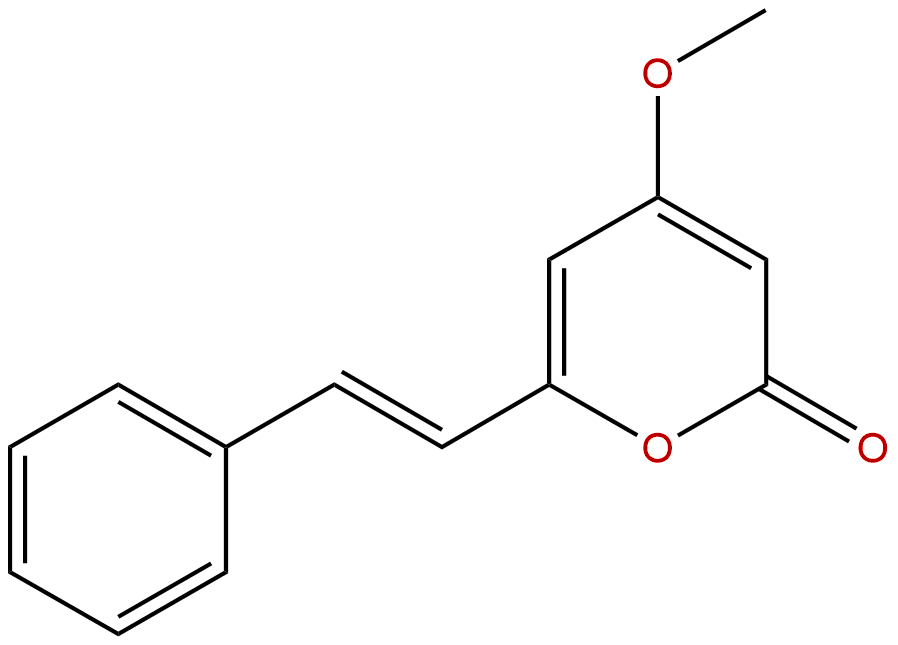
DemethoxyyangoninCAS No.:15345-89-8
|
||||||||||
 |
|
|
||||||||

| Catalogue No.: | BP0474 |
| Formula: | C14H12O3 |
| Mol Weight: | 228.247 |
Product name: Demethoxyyangonin
Synonym name:
Catalogue No.: BP0474
Cas No.: 15345-89-8
Formula: C14H12O3
Mol Weight: 228.247
Botanical Source: Piper methysticum Forst
Physical Description:
Type of Compound: Phenols
Purity: 95%~99%
Analysis Method: HPLC-DAD or/and HPLC-ELSD
Identification Method: Mass, NMR
Packing: Brown vial or HDPE plastic bottle
Storage: Store in a well closed container, protected from air and light. Put into refrigerate or freeze for long term storage.
Whenever possible, you should prepare and use solutions on the same day. However, if you need to make up stock solutions in advance, we recommend that you store the solution as aliquots in tightly sealed vials at -20℃. Generally, these will be useable for up to two weeks.
The product could be supplied from milligrams to grams
Inquire for bulk scale.
Description:
Desmethoxyyangonin is a reversible inhibitor of MAO-B, it may have important therapeutic value for treatment of neurodegenerative disorders and Parkinson's Disease. Desmethoxy yangonin protects LPS or LPS/D-GalN-induced damages in cell or liver tissues mainly through de-regulating IKK/NFκB and Jak2/STAT3 signaling pathways.
References:
PLoS One. 2013 Oct 15;8(10):e77626.
A plant kavalactone desmethoxy yangonin prevents inflammation and fulminant hepatitis in mice.
An active compound of the plant rhizomes, Desmethoxy yangonin (DMY), was identified in this study for its novel effect against endotoxin lipopolysaccharide (LPS)-stimulated inflammation in murine macrophages and LPS/D-galactosamine (LPS/D-GalN)-induced fulminant hepatitis in mice.
METHODS AND RESULTS:
Desmethoxy yangonin was observed to significantly inhibit proliferation and activation of T cells ex vivo and the activity of several pro-inflammatory mediators in vitro. Desmethoxy yangonin also protected LPS/D-GalN-induced acute hepatic damages in mice through inhibiting aminotransferases activities and infiltrations of inflammatory macrophages, neutrophils and pathogenic T cells into the liver tissues. In addition, pretreatment with Desmethoxy yangonin significantly improved the survival rate of LPS/D-GalN-treated mice to 90% (9/10), compared to LPS/D-GalN-treated group (40%, 4/10). UPLC/MS platform-based comparative metabolomics approach was used to explore the serum metabolic profile in fulminant hepatic failure (FHF) mice with or without the Desmethoxy yangonin pretreatment. The results showed that LPS/D-GalN-induced hepatic damage is likely through perturbing amino acid metabolism, which leads to decreased pyruvate formation via catalysis of aminotransferases, and Desmethoxy yangonin treatment can prevent to a certain degree of these alterations in metabolic network in mouse caused by LPS/D-GalN.
CONCLUSIONS:
Mechanistic investigation demonstrated that Desmethoxy yangonin protects LPS or LPS/D-GalN-induced damages in cell or liver tissues mainly through de-regulating IKK/NFκB and Jak2/STAT3 signaling pathways.
Planta Med., 2015, 81 - PB19
Isolation and characterization of desmethoxyyangonin from Renealmia alpinia as a selective reversible inhibitor of human Monoamine Oxidase B.
Renealmia alpinia (Zingiberaceae), a medicinal plant of tropical rainforests, is used to treat snakebites, as a febrifuge, analgesic, antiemetic, antiulcer, and anticonvulsant. The dichloromethane extract of R. alpinia leaves showed potent inhibition of recombinant human MAO-A and -B.
METHODS AND RESULTS:
Phytochemical studies yielded six known compounds including, pinostrobin, pinostrobin chalcone, sakuretin, sakuretin-4'-methyl, yashabushidiol, and Desmethoxy yangonin. Desmethoxy yangonin displayed strong inhibition of MAO-A and -B (Ki values 0.922 and 0.031μM, respectively), with about 30 fold more selectivity against MAO-B. The kinetic analysis of the inhibition and equilibrium dialysis dissociation assay of the enzyme-inhibitor complex showed reversible binding of
CONCLUSIONS:
Desmethoxy yangonin with MAO-A and -B. Selective reversible inhibitors of MAO-B have important therapeutic value for treatment of neurodegenerative disorders and Parkinson's Disease.
HNMR of Demethoxyyangonin

HPLC of Demethoxyyangonin
